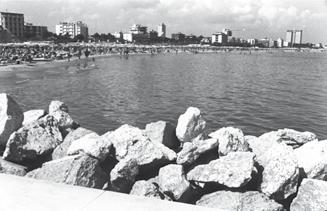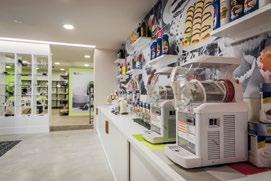
9 minute read
MIMA STORY Postcards from past to present
postcards tra passato e presente
la trasformazione dei luoghi di vacanza analizzata attraverso la ‘rifotografia’
Advertisement
L’ incontro con due libri e una veloce chiacchierata sono lo spunto per un singolare viaggio nel tempo attraverso immagini di ieri e di oggi: Cervia in cartolina, pubblicazione di una decina di anni fa, che ha avuto il merito di sistematizzare e valorizzare un’importante raccolta di cartoline postali provenienti dalla collezione privata di Gianfranco Luciani, e il più recente
Di Padre in Figlio, una ricerca sociologica sul turi
smo balneare romagnolo di Chiara Francesconi sono i due volumi galeotti. Della chiacchierata con la ricercatrice ci è piaciuto mettere a fuoco il concetto di “rifotografia” (riprendere lo stesso luogo possibilmente dalla stessa angolazione per ottenere in tutto e per tutto lo stesso scatto in tempi diversi) per raccontare alcuni luoghi simbolo di Milano Marittima e delle altre località cervesi scoprendone le trasformazioni nel tempo. Poniamo quasi riflesse allo specchio due immagini del famosissimo canalino. La prima datata a metà anni Cinquanta, la seconda rifotografata nel 2002. Qui il confronto passato presente avviene con due foto che mostrano turiste in posa. Eleganti, curate, alla moda, insomma negli anni 2000 come negli anni Cinquanta siamo in presenza a Milano Marittima di un turismo d’elite e questa, si può dire, è rimasta sicuramente una connotazione nel tempo della località turistica più esclusiva della Riviera. Il canalino nelle due foto non ha subito grandi trasformazioni, nella zona circostante però si notano i



cambiamenti, sono nati nuovi edifici, ma in generale l’equilibrio tra la città giardino, la natura e le esigenze del turismo di massa viene mantenuto. Ecco la cartolina che ritrae la spiaggia di Milano Marittima vista dal porto-canale, bagnanti anni cinquanta in riva al mare; le onde che si infrangono sulla battigia, la spiaggia con gli ombrelloni. Si può notare che Milano Marittima, nata a inizio Novecento proprio come città delle vacanze (dei milanesi e della borghesia lombarda) sia diventata poi la regina del boom vacanziero con spiaggia attrezzata, mentre tra la vegetazione della pineta spuntano gli alberghi. Chiara Francesconi analizzando la cartolina e la rifotografia del 2002 scrive nel suo libro: L’industria turistica appare viaggiare a gran velocità e il luogo sembra volere “accogliere ed ospitare tutti”, impressione quest’ultima che si ripropone nell’immagine del presente. Le peculiarità della spiaggia appaiono le medesime: affollamento, organizzazione estrema dello spazio, stabilimenti che si


susseguono l’uno all’altro. Muta il paesaggio dietro, nonostante la presenza del verde dei pini sia ancora significativa: vi è stato un importante sviluppo delle strutture alberghiere - a giudicare dai caratteri prevalentemente avvenuto negli anni ‘60 e all’inizio dei ‘70 - così come dei palazzi e degli edifici dove si trovano le seconde case degli “amanti” di Milano Marittima, che ogni anno “tornano al mare”. In particolare si nota la presenza dei due grattacieli, punti e simboli presenti in quasi tutte le località della costa sud romagnola. La terza postcard scelta rappresenta il Grand Hotel di Cervia. Ci siamo spostati di pochi chilometri, per proprorre un altro simbolo del turismo balneare. La cartolina ha il timbro postale del 1941, la rifotografia è del 2002, il Grand Hotel nella sua struttura non è molto cambiato, nonostante gli interventi di ristrutturazione. Eppure tra le due immagini sono passati più di sessant’anni. L’abbattimento della cinta muraria sembra voler accentuare una maggiore apertura verso il mondo esterno e i nuovi turisti. “Lo scopo di questo studio è quello di evidenziare le potenzialità conoscitive insite in un percorso di ricerca di sociologia del territorio che si basa sulle immagini e sul confronto fra passato e presente – commenta Chiara Francesconi - Lo “stimolo” ad effettuare tale tipo di lavoro è nato dalla presenza dell’interessante e rara collezione di cartoline postali, messa a disposizione dalla biblioteca/ iconoteca del Comune di Cervia, che ci offre uno “spaccato visivo” di alcune località e della loro evoluzione, che parte circa all’inizio del Novecento e si dipana nell’arco di più di sessant’anni. Il materiale di base è, pertanto, di indubbio “fascino” per chi ha come costante obiettivo - essendo appunto sociologo del territorio - quello di riuscire a comprendere l’organizzazione e lo sviluppo dei luoghi e delle specifiche realtà sociali che vanno in essi strutturandosi e modellandosi.
ПОЧТОВЫЕ ОТКРЫТКИ МЕЖДУ ПРОШЛЫМ И НАСТОЯЩИМ
Встреча с двумя книгами и быстрый разговор - это отправная точка для путешествия во времени при помощи старых и новых изображений: Червия на открытке, издание, вышедшее около десяти лет назад, задача которого заключалась в систематизации и демонстрации ценности почтовых открыток из внушительной частной коллекции Джанфранко Лучани, и более поздняя работа От Отца к Сыну, социологическое исследование романьольского пляжного туризма Кьяры Франческони. Из разговора с исследовательницей нам понравилась концепция “повторного фотографирования” (фотосъемка одного и того же места по возможности в одном и том же ракурсе для получения точно такого же снимка годы спустя), которая использовалась для того, чтобы рассказать о некоторых символических местах Милано Мариттима и других курортах провинции Червия и чтобы проследить за переменами, которые произошли здесь с течением времени. Вот открытка, на которой запечатлен пляж Милано



Мариттима, снятый со стороны порта-канала, с отдыхающими пятидесятых годов на берегу моря, и волны на линии прибоя. Милано Мариттима, который был основан в начале ХХ века как городкурорт (куда приезжали миланцы и ломбардийская буржуазия), становится излюбленным местом отдыха с оборудованными пляжами, а в зелени сосновой рощи один за другим начинают появляться отели. Кьяра Франческони, сравнивающая открытку и фотографию, снятую в 2002 г., пишет в своей книге: Похоже, что туристическая индустрия движется с огромной скоростью, и кажется, что это место хочет “принять всех” - это впечатление остается также после просмотра последних фотографий курорта. Точно таким же выглядит и пляж: множество отдыхающих, предельная организация пространства, сменяющие одна другую купальни. Изменяется пейзаж за пляжами несмотря на все еще буйную зелень сосен: здесь появилось множество гостиничных структур - судя по их внешнему виду, в 60-х - 70-х гг., а также здания и строения, в которых находятся летние



квартиры “любителей” Милано Мариттима, которые каждый год “едут на море”. В частности, выделяются два небоскреба, места и символы, имеющиеся почти во всех курортных городках южного романьольского побережья. Мы продолжаем наше путешествие - фотографии канала кажутся зеркальным изображением друг друга. Первая фотография сделана в середине 50-х гг., а вторая - в 2002 г. На этих двух фотографиях, где запечатлены позирующие туристки, можно сравнить прошлое и настоящее. Элегантные, ухоженные, модные - и в начале нового века, и в 50-х гг. Милано Мариттима остается местом элитного туризма. Эта характеристика отличает самый эксклюзивный курорт Ривьеры и по сей день.

Канал, изображенный на двух фотографиях, остался почти как прежде, хотя в близлежащей зоне видны изменения - появились новые здания, но в общем заметно сохранившееся равновесие между городомсадом и природой и требованиями массового туризма. На третьей открытке - Гранд-отель в Червии. Мы переместились на несколько километров, чтобы показать еще один символ пляжного туризма. На открытке - почтовый штамп 1941 года, новая же фотография снята в 2002 г. Как видно, структура Гранд-отеля почти не изменилась, несмотря на реконструкционные работы. Но все-таки эти снимки разделяет более 60 лет... Снесение городской крепостной стены стало неким символом большей открытости внешнему миру и новым туристам.
Postcards from past to present
The encounter with two books and a quick chat are the inspiration for an unusual journey through time looking at pictures from the past and the present: Cervia in cartolina (Cervia in postcards), published about ten years ago, which had the merit of organising and utilising an important selection of postcards from the private collection of Gianfranco Luciani, and the more recent Di Padre in Figlio, una ricerca sociologica sul turi smo balneare romagnolo (From father to Son, sociological research on seaside tourism in Romagna) by Chiara Francesconi. In the chat with the researcher we wanted to get a clear idea of the con cept of rephotography (taking a photo of the same place and if possible from the same angle to obtain exactly the same shot) to describe some locations of symbolic value for Milano Marittima and other resorts in the area of Cervia, and to discover how they were transformed over the ye ars. Here is the postcard depicting the beach of Milano Marittima seen from the port-canal, bathers of the nineteen fifties on the beach, waves breaking on the water’s edge. Milano Marittima, which grew at the be ginning of the nineteen hundreds as a holiday resort (for the Milanese and middle class of Lombardy) then became the queen of the holiday boom with equipped beaches and hotels sprouting up amid the vegeta tion of the pinewood. Chiara Francesconi, analysing the postcard and the rephotograph of 2002, writes in her book: The tourism industry seems to travel at great speed and the place seems to want to “welcome and accommodate everyone”, giving an impression that recurs in the picture of the present. The details of the beach seem to be the same: crowding, extreme organisation of the space, beach establishments that follow one after another. The scene in the background is quite different although there is still a significant amount of green pinewood: there has been a substantial amount of hotel construction – judging by the features appe aring mainly in the sixties and seventies – like the blocks and buildings where the second homes of Milano Marittima lovers who return to the seaside every year are located. Something particularly noticeable is the two tower blocks, points and symbols present in almost all the resorts of the coast of southern Romagna. Moving on to compare two pictures of the canal, the first dates from the middle of the fifties while the second is a rephotograph taken in 2002. Here the comparison of past and present is made with two photos that show tourists posing. They are elegant, wellgroomed, in style, basically in the 2000s just as in the fifties the tourism in Milano Marittima is for the elite and it is true to say that this is certainly still the connotation of the most exclusive resort on the coast of Romagna. The small canal in the two photos has not undergone any great changes but in the surrounding area some changes can be seen; there are some new buildings but in general the balance between the garden city and nature and the requirements of mass tourism remains undisturbed. The third postcard shows the Grand Hotel of Cervia. We moved a few kilometres to show another symbol of seaside tourism. The postcard has the postal cancellation dated 1941, the rephotograph is from 2002, the structure of the Grand Hotel has not changed much in spite of the remo delling works and yet there are more than seventy years between the two pictures. The demolition of the city walls seems to want to accentuate greater openness to the world outside and new tourists.










